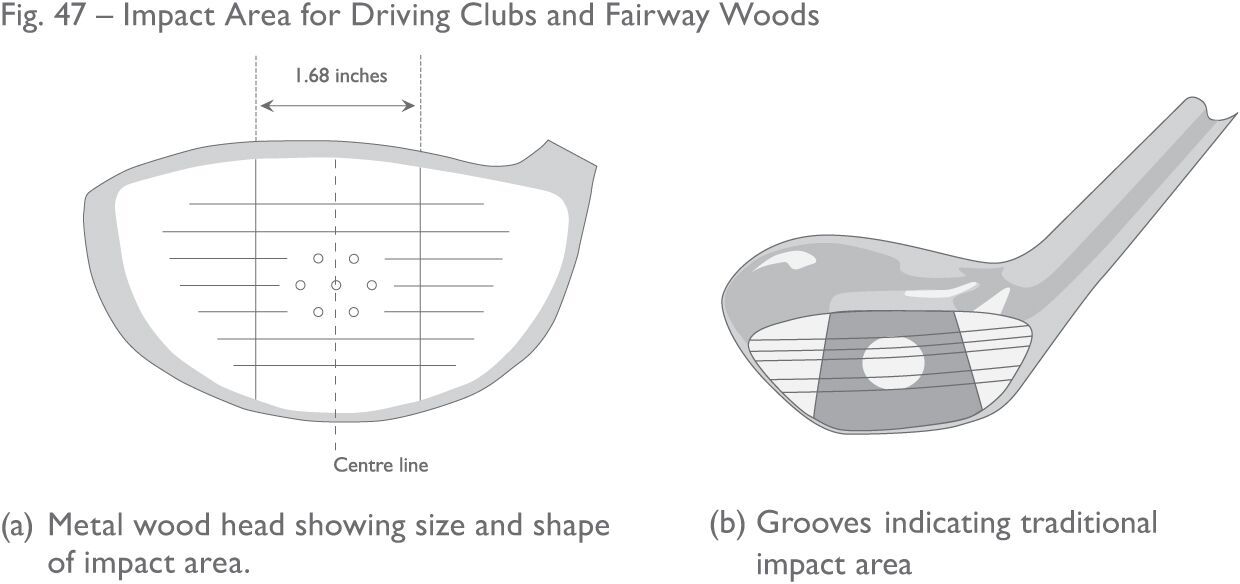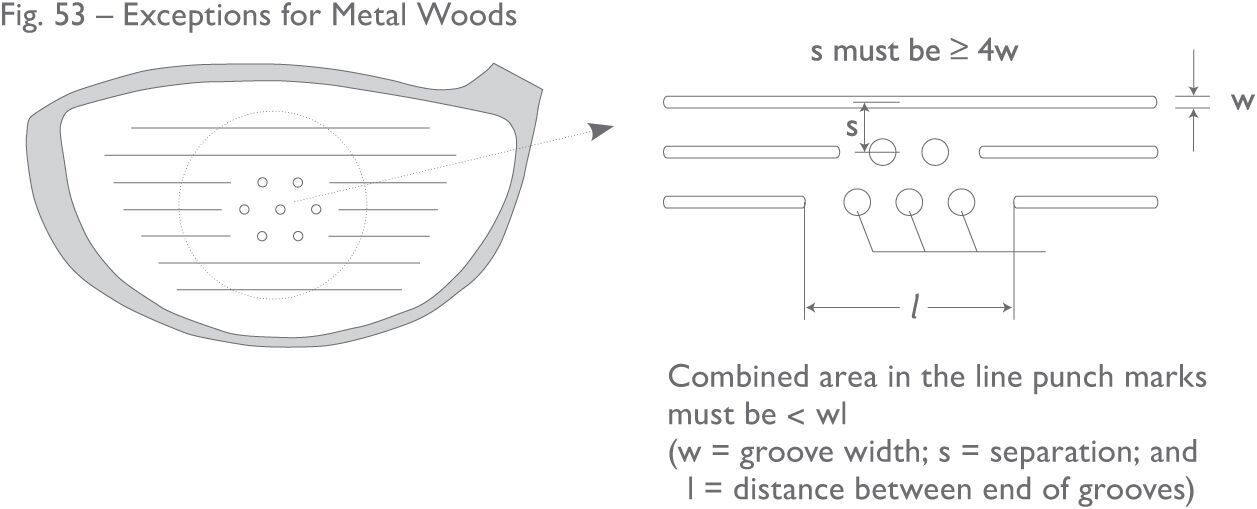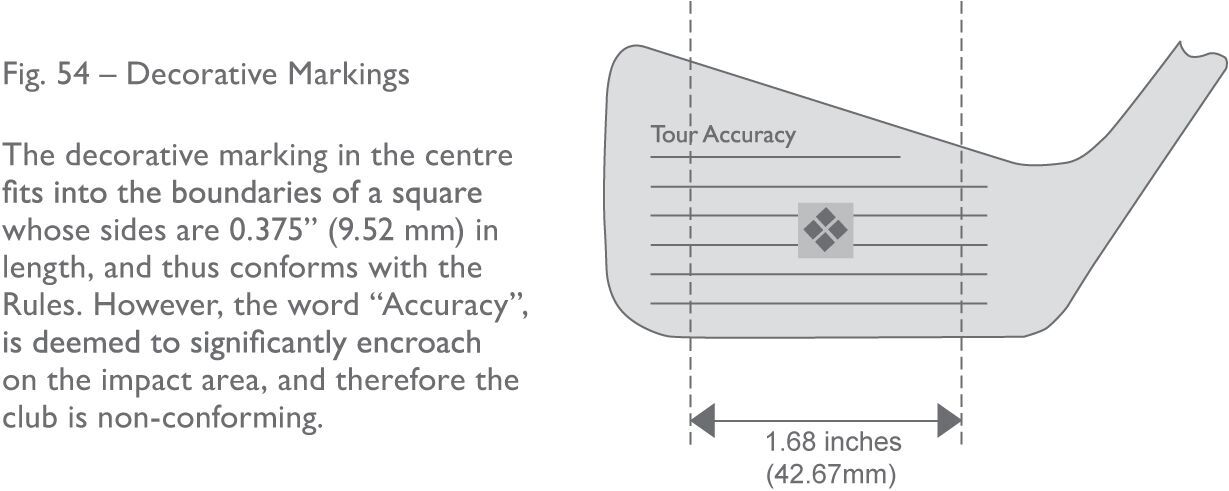5. Club Face
a. General
Interpretation of Rule 5.a
5.a(1) - Spin
If claims of excessive spin are made by the manufacturer, or if there is strong supporting
evidence of excessive spin, then the club would be deemed to be non-conforming.
5.a(2) - Hardness
The “hardness” provision is particularly relevant to putters, many of which have a
urethane or other “soft” material inset in the face.
The measure for hardness is made using a durometer. A putter face must be no less
than 85 on a Shore A scale durometer. A simple measure of hardness in the field would
be to use a fingernail. If a fingernail leaves a significant imprint in the face of
a club, it is possible that the material does not satisfy the “hard and rigid” requirement.
The face of a wood or iron club must be substantially harder than a putter face, i.e.
no less than 75 on the Shore D scale.
5.a(3) - Rigidity
In the field, “rigidity” is interpreted to mean that the face should not have any
visible signs of movement or flex when manual pressure is exerted.
5.a(4) - Concavity
Where there is an inset in the face of the club, it should be flush with the rest
of the face so that the face can still be considered smooth with no concavity. While
we interpret concavity in this provision strictly, we also recognize that, due to
manufacturing tolerances, it is sometimes difficult for every insert to be exactly
flush with the rest of the face. As a result, we allow an inset to be up to 0.006
inches (0.15 mm) proud of the rest of the face or no deeper than 0.004 inches (0.1
mm) below the rest of the face.
b. Impact Area Roughness and Material
Interpretation of Rule 5.b
5.b(1) - Definition of “Impact Area”
Irons
For iron clubs, the “impact area” is deemed to be that part of the club face where
a treatment has been applied (for instance grooves, sandblasting, etc.) or the central
strip down the middle of the club face having a width of 1.68 inches (42.67 mm), whichever
is greater.
Woods
The impact area on driving clubs and fairway woods is deemed to be the central strip
down the middle of the clubface having a width of 1.68 inches (42.67 mm) – see Figure
47a.
NOTE: Grooves and/or punch marks indicating a traditional impact area (see Figure
47b), or any groove which encroaches into the heel or toe portions of the impact area
by less than 0.25 inches (6.35 mm), will not be considered to be within the impact
area. However, any such markings must not be designed to unduly influence, or have
the effect of unduly influencing, the movement of the ball.
For clubs with insets in the face, the boundary of the impact area is defined by the
boundary of the inset, as long as any markings outside the boundary do not encroach
the impact area by more than 0.25 inches (6.35 mm) and/or are not designed to influence
the movement of the ball.
Moreover, the inset itself must extend to at least 0.84 inches (21.34 mm) either side
of the centre line of the face and to within at least 0.2 inches (5.08 mm) of the
top line and leading edge of the face.
IMPORTANT NOTE:
The above definitions of the impact area only apply to models of clubs manufactured
on or after 1 January 2010. For clubs manufactured prior to 1 January 2010, please
refer to the end of Supplementary Paper B.

5.b(2) - Impact Area Roughness
When dealing with the surface roughness of a club face (not including putters, see
Section 5f), the claims made by the manufacturer must be taken into account – especially
if there is a claim that the roughness of the face influences the movement of the
ball. In the absence of such claims, the ruling is made purely on the amount of roughness
there is. Sandblasting or other treatments of roughness greater than 180 micro inches
(4.5 µ metre) are not permitted. In addition to this requirement for roughness, milling
is not permitted if the crest to trough depth exceeds 0.001 inches (0.025 mm). A reasonable
tolerance is allowed for both of the above measurements. Non-conforming sandblasting
or milling usually feels rough to the touch.
5.b(3) - Impact Area Material
The requirement that the whole of the impact area must be of the same material does
not apply to clubs made of wood or putters (see Section 5f). The reason why it does
not apply to wooden headed clubs is to allow the continued use of traditional wooden
clubs which have plastic insets and brass screws in the centre of the face. This design
was commonly used in the old persimmon woods, some of which may still be in use. It
is worth noting that a club face or inset made of a composite material would be considered
to be of a single material and, therefore, would not be contrary to this provision.
Metal wood club faces which have insets of different material not trapezoidal in shape
may be permitted if the height of the inset meets the definition of the impact area
and the width of the inset is the same as the height in at least one point. However,
in order to preserve the intent of the “same material” Rule, clubs which have unusually
shaped insets of different material (i.e. other than circular, oval, square or rectangular)
would not normally be permitted.
If an inset of different material is permitted under the above guideline, the inset
would be considered the impact area for that club. Therefore, any markings outside
that area need not conform to the specifications in Section 5c. However, such markings
must not be designed to unduly influence the movement of the ball.
c. Impact Area Markings
Interpretation of Rule 5.c
5.c(1) - General
The groove and punch mark specifications were updated in 2010 and many pre-2010 models
of clubs do not meet the new specifications. The above Notes mean that the vast majority
of golfers can continue to carry clubs manufactured prior to 2010 until at least 2024.
Supplementary Paper B sets out guidance on how to measure width, depth and separation
of grooves using the ‘ink and scratch’ method and how to determine the conformance
status of a club to the pre-2010 Equipment Rules. This is an adequate method for use
in the field where the Committee has not introduced the Groove and Punch Mark Model
Local Rule (i.e. at the non-elite level).
There are several methods which can be used to measure grooves and punch marks against
the updated specifications detailed above – most of which require specialized equipment.
Full details of the procedure for measuring club face markings and determining their
status against the post-2010 specifications can be found on The R&A’s and USGA’s websites.
A summary can also be found in Supplementary Paper C.
As noted, The R&A and USGA do not recommend adoption of the Model Local Rule G-2 unless
the competition involves professional-level players and/or players at the highest
levels of amateur golf. In order to assist players and officials to determine whether
a player’s clubs meet the condition, The R&A and USGA have compiled an informational
database of irons, wedges, fairway woods and hybrids that have been submitted to either
organization and evaluated for conformance to the updated specifications. This information
is available on The R&A’s and USGA’s websites, respectively.
Notably, clubs where the face markings have been purposely altered, for example, by
re-grooving must conform to the 2010 groove and punch mark specifications. However,
clubs which have only been refurbished back to their original state (perhaps by light
sandblasting) may still benefit from the period of grace given to pre-2010 models.
For the avoidance of doubt, all new models available after 31 December 2009 must conform
to the current Equipment Rules.
5.c(2) - Groove/Punch Mark Combinations
If punch marks are used in conjunction with grooves, the following guidelines apply:
Iron Clubs
-
Small punch marks which are in line with a conforming groove, and which would be totally
contained within a continuation of the groove do not have to meet the punch mark to
groove specifications (See Figure 51). However, if the diameter of such punch marks
exceeds the width of the groove, then they must meet the specifications.


Metal Wood Clubs
Provided the following three conditions are satisfied, the above interpretation of
the specifications for punch marks in line with a groove may also be granted for metal
woods, even if the punch marks would not be totally contained by the continuation
of the groove:
-
there must be no more than three in-line punch marks in the part of the groove that
is missing (i.e. in the gap between the ends of the partial grooves);
-
the combined area of all of the in-line punch marks in any one such gap must not exceed
the area of the missing groove; and
-
the separation of the in-line punch marks from adjacent parallel grooves – measured
from centre to centre – must be at least four times the width of the groove.
Fig. 53 illustrates each of the above conditions:

d. Decorative Markings
Interpretation of Rule 5.d
This provision permits small, decorative logos in the centre of the face or at the
side of the impact area (see Fig. 54). Decorative markings or logos that marginally
encroach on the impact area, i.e. by less than 0.25 inches (6.35 mm), may be permitted.
However, any such markings must not be designed to unduly influence or have the effect
of unduly influencing the movement of the ball. Markings outside the impact area which
are designed to influence the movement of the ball when it has been mis-hit would
be contrary to this provision.

f. Putter Face
Interpretation of Rule 5.f
In addition, if a groove or the grooves on the face of a putter exceed 0.035 inches
(0.9 mm) in width and 0.020 inches (0.508 mm) in depth, the following guidelines apply:
-
The width may not exceed 0.060 inches (1.524 mm);
-
The width to spacing ratio must be no less than 1:1; and
-
The depth must be less than the width, and may not exceed 0.040 inches (1.016 mm).




